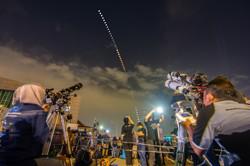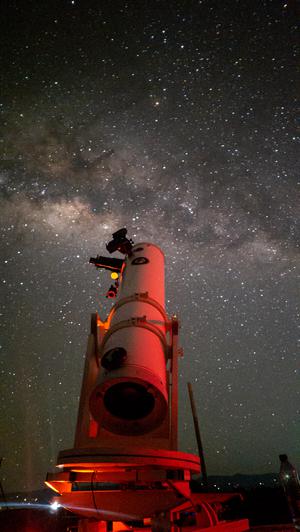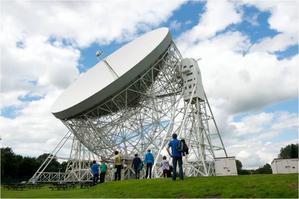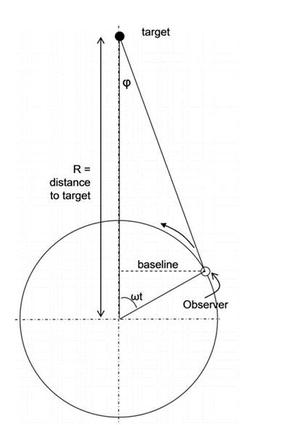Glossary term: Telescope
Description: A telescope is a device that collects photons (of visible light or other wavelengths) from distant objects and provides information (e.g. an image) about them to an observer. Early telescopes (from the beginning of the 17th century) used lenses as optical elements (see refracting telescope). Lenses are limited in how large they can be made, so in order to see fainter objects in greater detail with larger telescopes, mirrors (see reflecting telescope) were instead used to focus the light. The largest optical telescopes are reflecting telescopes. In the 20th century, telescopes for studying other regions of the electromagnetic spectrum were invented, so there now exist radio telescopes, infrared telescopes, X-ray telescopes, etc. Because celestial sources are faint, astronomers tend to build large aperture telescopes to collect more light and reach finer angular resolutions.
Related Terms:
- Electromagnetic Radiation
- Infrared Telescope
- Radio Telescope
- Reflecting Telescope
- Refracting Telescope
- Angular Resolution
- X-ray Telescope
- Lens
- Mirror
See this term in other languages
Term and definition status: This term and its definition have been approved by a research astronomer and a teacher
The OAE Multilingual Glossary is a project of the IAU Office of Astronomy for Education (OAE) in collaboration with the IAU Office of Astronomy Outreach (OAO). The terms and definitions were chosen, written and reviewed by a collective effort from the OAE, the OAE Centers and Nodes, the OAE National Astronomy Education Coordinators (NAECs) and other volunteers. You can find a full list of credits here. All glossary terms and their definitions are released under a Creative Commons CC BY-4.0 license and should be credited to "IAU OAE".
If you notice a factual error in this glossary definition then please get in touch.
Related Media
The Eclipse Between Us, by Muhammad Rayhan, Indonesia
Credit: Muhammad Rayhan/IAU OAE
License: CC-BY-4.0 Creative Commons Attribution 4.0 International (CC BY 4.0) icons
Learning Nights
Credit: Juan Pablo Botero Londoño/IAU OAE (CC BY 4.0)
License: CC-BY-4.0 Creative Commons Attribution 4.0 International (CC BY 4.0) icons
Related Activities
Big Telescopes: Gravity
astroEDU educational activity (links to astroEDU website) Description: Observing what gravity is doing to the Universe
License: CC-BY-4.0 Creative Commons Attribution 4.0 International (CC BY 4.0) icons
Tags:
Experiment
Age Ranges:
12-14
, 14-16
Education Level:
Middle School
, Secondary
Areas of Learning:
Guided-discovery learning
, Interactive Lecture
, Modelling
Costs:
High Cost
Duration:
1 hour 30 mins
Group Size:
Group
Skills:
Analysing and interpreting data
, Asking questions
, Developing and using models
, Planning and carrying out investigations
The 4-Point Backyard Diurnal Parallax Method
astroEDU educational activity (links to astroEDU website) Description: Measure the distance to an asteroid with a novel technique
License: CC-BY-4.0 Creative Commons Attribution 4.0 International (CC BY 4.0) icons
Tags:
Hands-on
, Measurement
, Distances
, CCD imaging
, astrometry
Age Ranges:
16-19
, 19+
Education Level:
Informal
, Secondary
, University
Areas of Learning:
Guided-discovery learning
, Project-based learning
Costs:
High Cost
Duration:
several days
Group Size:
Group
Skills:
Analysing and interpreting data
, Asking questions
, Communicating information
, Constructing explanations
, Planning and carrying out investigations
, Using mathematics and computational thinking
How do telescopes work?
astroEDU educational activity (links to astroEDU website) Description: Let's discover telescopes and experiment simple optics
License: CC-BY-4.0 Creative Commons Attribution 4.0 International (CC BY 4.0) icons
Age Ranges:
10-12
Education Level:
Primary
Areas of Learning:
Guided-discovery learning
, Historical focussed activity
, Observation based
Costs:
Medium Cost
Duration:
1 hour
Group Size:
Group
Skills:
Asking questions













